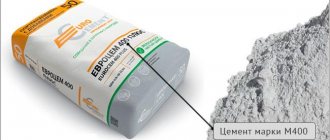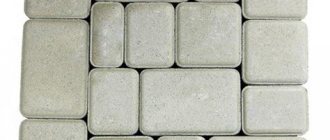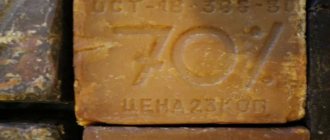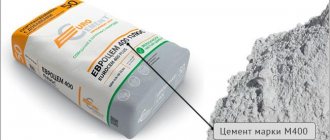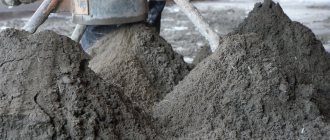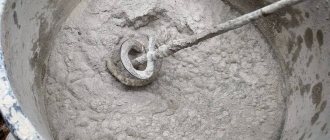People learned to use something similar to cement in construction back in ancient times. These were mixtures of lime with crushed old bricks or volcanic ash - it was noticed that under the influence of water such compositions begin to gain strength, and the further they go, the harder they become. But all these were just “blind searches”, and a real revolution in the construction industry occurred in the 19th century, after the development of cement production technology and the beginning of its mass use.
Cement mortar proportions
Today, without cement, it is probably impossible to imagine any construction at all. This material is actively used for the manufacture of finished structures in factories, for mixing concrete, masonry, and finishing mortars. It is clear that for each application there are different technologists for preparing working compositions and their own proportions of the components to be mixed. This is what we will talk about in this publication - cement mortar proportions for the compositions most commonly used in individual construction.
*Explanations for the calculator
- The calculator can calculate the volume for both whole numbers and fractions. Example: concrete volume 3m3, concrete volume 50l (0.05m3).
- The calculator implements calculations for a mixture with mobility P3 (9-10 cm of cone slump) for cement-lime mortars (according to SP82-101-98). Water consumption for mixtures with different mobility is based on experimental batches. The mobility you need can be viewed in the “Mobility” field, which is automatically filled in when you select “Solution purpose”.
Types of construction sand: how much does 1 cube of each weigh?
How much 1 cube of sand weighs is affected by its type, storage method and humidity level. According to GOST, the weight of standard construction sand is 1550-1700 kg/m? (18.5-20.4 kg/bucket). The weight of dry loose sand is 1440 kg/m?, and compacted sand is 1680 kg/m?. Wet standard sand has a weight of 1920 kg/m?.
There are several types of sand. Classification is based on how and where the material was mined. Sand used in construction is:
river – the production zone is located at the bottom of rivers. The material is characterized by purity, the shade is gray or yellow. The size of the fractions varies between 0.3-0.5 mm. Used for preparing mixtures, solutions, organizing a drainage system;
The most popular types of sand in construction are river and quarry sand.
- quarry - mining is carried out using an open method. The size of the fractions varies within a wide range - 0.6-3.2 mm. The scope of application extends to foundation work and sidewalk construction. In addition, sifted and washed quarry sand is used in finishing and plastering work, as well as in the recipe for preparing cement screed;
- marine – the production area is the seabed. The scope of application is wide, but the material is not in high demand because its cost is high.
Table 2. Sea, river and quarry sand: how much does 1 cube and 1 bucket weigh:
| Sand type | Specific gravity m? (kg) | Specific weight of bucket (kg) |
| River | 1630 | 19,5 |
| Career | 1500 | 18,3 |
| Nautical | 1620 | ? 19,4 |
The price of river sand with delivery per cubic meter is considered the most affordable of all if you need to purchase a material of natural origin. However, there are other types of sand - obtained artificially.
Artificial types of sand:
- slag;
- quartz;
- expanded clay.
There are artificial types of sand with expanded clay, slag and quartz impurities
Construction sand: how many cubes per ton
Specific gravity of sand per 1 cubic meter. m volume is calculated using the formula:
m = V*p, where
m – mass of material;
V – volume;
p – density level.
Using this formula, you can find out from the table how many cubic meters of sand are in a ton, and what is its specific gravity within the generally accepted unit of volume. For 1 cu. m, the weight of the material is equated to its density, and the bulk density can usually be obtained from suppliers involved in sales and delivery.
To calculate the weight of sand, you need to know its volume and density
Filling capacity of ZIL and KAMAZ dump trucks: how many cubic meters of sand are in the back
Despite the large tonnage of KAMAZ, all buyers still want to know how many cubic meters of sand are in the body of the vehicle, since this measure of weight is the generally accepted value used in all calculations.
KAMAZ usually carries 12 cubic meters of sand. How much ZIL can accommodate in its body is also a useful value, since many suppliers deliver building materials in smaller sizes. In this case, the capacity is 3 m². MAZ is used to deliver 6 m?.
The KAMAZ body can hold up to 18.5 tons of sand
It is very important to find out in advance, when ordering sand, how much a cube of bulk material you need costs, and how many kg it contains. The average price of river sand is 8,000 rubles/m
cubic, quarry - 500 rub./m. cube How much sand costs with delivery depends on the supplier, the volume of sand and the distance. Average prices for the service within one city and region are 2000-3000 rubles
The average price of river sand is 8,000 rubles/m. cubic, quarry - 500 rub./m. cube How much sand costs with delivery depends on the supplier, the volume of sand and the distance. Average prices for the service within one city and region are 2000-3000 rubles.
Algorithm for calculating the composition of a solution
Selection of solution composition for 1 m3 of sand
To implement the calculator, the data and calculation algorithm were taken from:
SP82-101-98: Preparation and use of mortars GOST 28013-98: Construction mortars. General technical conditions
1. Determine the consumption of binder (cement) per 1 m3 of sand depending on the selected brand of mortar and brand of cement.
We determine the cement consumption per 1m3 of sand using the formula:
2. Determine the volume of lime per 1 m3 of sand using the formula:
where Qв
– consumption of binder (cement) per 1 m3 of sand, kg
Vd
– inorganic additive (lime) per 1 m3 of sand, m3.
We determine the mass of lime per 1m3 of sand using the formula:
Qd = Vd * λ;
where Qd
– consumption of additive (lime) per 1 m3 of sand (kg);
λ
– bulk density of additive (lime) kg/m3;
3. We make up the proportion of the volumetric parts of the solution
You can also use the table of ready-made proportions in volumetric ratios (Table 4 SP82-101-98)
4. Determine the water consumption per 1 m3 of sand.
The approximate water consumption in SP82-101-98 is shown for a mixture with mobility P3 (9-10 cm depth of cone settlement). This mobility according to GOST 28013-98 is suitable for masonry made of solid bricks and ceramic stones. Water consumption for other mixture mobility is determined as a result of trial batches. We can select the mobility we need depending on the purpose of the solution using the table presented in GOST 28013-98
Calculation of materials per 1m3 of solution
An example of counting materials for 1 batch and for 1 m3 of solution is shown in Appendix A SP82-101-98.
For floor screed
Excerpts from the Recommendations for the installation of floors (to SNIP 3.04.01-87 “Insulating and finishing coatings”)
Appendix 1 Table 4
GOST standards, books, programs and calculators for calculating the composition of the solution
SP82-101-98: Preparation and use of mortars GOST 28013-98: Construction mortars. General technical conditions Recommendations for floor installation (to SNIP 3.04.01-87 “Insulating and finishing coatings”) Manual - mortars (example of calculation of materials for mortar)
Proportions of some concretes and cement-based mortars
Concrete for pouring monolithic foundations
Monolithic concrete foundations are rightly called universal. They are capable of becoming a reliable foundation for almost any building and in a wide variety of, even very unfavorable, conditions.
Such foundations include strip and slab foundations. But the use of concrete is not at all limited to these varieties. There is no way to do without it when concreting the supports of a columnar foundation, for fastening, filling or even completely casting piles, for creating a reinforced concrete frame - a grillage along an established pile field, etc.
The ingredients of concrete for pouring foundations are:
- Cement - here and further in the article we will mainly consider in detail the production of mortars based on PC400 cement. When specifying proportions, fresh, non-caked cement with a bulk density of approximately 1300 kg/m³ is taken into account.
- Sand - ordinary construction sand, with a fraction of 1.5 to 3 mm, maximally purified from organic and clay contaminants, ideally sifted. Low, up to 10% (and according to GOST – generally up to 7%) sand humidity is important. First of all, it affects its bulk density - wet sand is heavier. But this is not even the main thing, since the dosage of sand is often carried out in volumetric units. It is important that excess moisture in the sand can change the optimal water-cement ratio of concrete, causing it to lose certain qualities.
The indicated proportions of sand imply the use of material with a moisture content of no more than 10% (this is the maximum!)
By the way, a sand moisture content of more than 10% begins to affect its volume, that is, it is even easier to make a serious mistake when dosing the batch.
- Crushed stone becomes a mandatory filler in such concrete. In solutions made and poured independently, it is more convenient to use crushed stone with a fraction of up to 20÷25 mm - the quality will not decrease, and mixing and distributing concrete will become much easier.
Granite crushed stone with a fraction of 5÷20 mm is an excellent material for pouring your own foundation.
Crushed stone should also not have significant contamination or foreign impurities. The approximate bulk density of this component is 1600 kg/m³.
Instead of crushed stone, gravel of the same fraction can be used.
- It would seem that you can add water? Meanwhile, certain requirements are also imposed on it, and the main thing is cleanliness. Not to the food stage of cleanliness, of course, but in any case without garbage, silt, mud. Contamination of water with fuels, lubricants or paints and varnishes is completely unacceptable.
The tables below show the proportions for mixing concrete of different grades from PC400 and PC500 cement
Table of concrete proportions for foundations based on PC400 cement
| Planned strength grade (class) of concrete | Proportions of ingredients by weight (cement: sand: crushed stone) | Proportions of ingredients by volume (cement: sand: crushed stone) | Volume ratio of finished concrete to spent cement |
| M100 (B7.5) | 1 : 4.6 : 7.0 | 10 : 41 : 61 | 7.8 |
| M150 (V10÷V12.5) | 1 : 3.5 : 5.7 | 10 : 32 : 50 | 6.4 |
| M200 (B15) | 1 : 2.8 : 4.8 | 10 : 25 : 42 | 5.4 |
| M250 (B20) | 1 : 2.1 : 3.9 | 10 : 19 : 34 | 4.3 |
| M300 (B22.5) | 1 : 1.9 : 3,7 | 10 : 17 : 32 | 4.1 |
| M400 (B30) | 1 : 1.2 : 2.7 | 10 : 11 : 24 | 3.1 |
Table of concrete proportions for foundations based on PC500 cement
| Planned strength grade (class) of concrete | Proportions of ingredients by weight (cement: sand: crushed stone) | Proportions of ingredients by volume (cement: sand: crushed stone) | Volume ratio of ready-mixed concrete to grouted cement |
| M100 (B7.5) | 1 : 5.8 : 8.1 | 10 : 53 : 71 | 9.0 |
| M150 (V10÷V12.5) | 1 : 4.5 : 6.6 | 10 : 40 : 58 | 7.3 |
| M200 (B15) | 1 : 23.5 : 5.6 | 10 : 32 : 49 | 6.2 |
| M250 (B20) | 1 : 2.6 : 4.5 | 10 : 24 : 39 | 5.0 |
| M300 (B22.5) | 1 : 2.4 : 4.3 | 10 : 22 : 37 | 4.7 |
| M400 (B30) | 1 : 1.6 : 3.2 | 10 : 14 : 28 | 3.6 |
Now - what concrete to choose for the foundation?
A proposal proven by practice would be this: if the foundation is being built for a one-story light house (for example, a frame one, made of timber or logs, made of aerated concrete and similar materials), for any outbuildings, garage, gazebo, etc., then it will be quite enough grade strength M200 (class B15).
And the concrete grade M300 (class B22.5) can generally be called universal - in the field of individual construction, you probably won’t find any restrictions for such foundations.
To find out how much concrete will be needed to pour the foundation, you will first have to calculate the volume of the slab or tape. For a person familiar with the basics of geometry, this should not present much difficulty:
- For a slab foundation, the area of this slab (m²) in plan is multiplied by its thickness (m). The area of the slab, even if it is of some complex shape, is also not particularly difficult to determine. If you still have problems with this issue, we will help...
Calculating the area of even a complex figure is easy!
When carrying out construction or repairs, one often has to resort to calculating areas. Moreover, some variations of forms can confuse a person who is far from mathematics. the calculation of areas , will be an excellent help for him .
- For a strip foundation, the volume is calculated by multiplying the length of the strip by its height (from the bottom to the top end) and thickness. All values are in meters. In this case, you should show a certain amount of intelligence - some sections of the tape, for example, internal jumpers for capital partitions, may differ in depth and (or) thickness. This means that they are calculated separately, and then the results are summed up.
Do not forget that, as a rule, when calculating the amount of building materials, a certain reserve is included, about 10%.
So, if there is a value for the required volume of concrete for pouring the foundation, but you plan to prepare it yourself, you can take the table and sit down to calculate the amount of materials. It’s even easier to use our online calculator.
Calculator for calculating concrete proportions for pouring a foundation
Go to calculations
Explanations for the calculator
There is probably no need for any special explanation. But nonetheless…
- When indicating the total volume, the unit of measurement is cubic meters. When specifying a value, only a period is used to separate the decimal fraction—values cannot be entered with a comma.
- Both calculations, M200 and M300, are given for the use of PC400 grade cement.
- If the owners have a concrete mixer at their disposal, then it is easy to calculate the number of ingredients for a one-time batch. To do this, simply indicate the working volume of the concrete mixer in the field, also in cubic meters. It happens that the owner is used to operating with buckets - for such a hint: one bucket per 10 liters is 0.01 m³. that is, for example, if it is known that the concrete mixer hopper is designed for, say, 12 buckets, then this corresponds to a volume of 0.12 m³.
The calculation results are shown in mass and volumetric terms. In this case, volumes can be shown in cubic meters (for example, to order the required amount of materials), in liters and in buckets, as the most visual and convenient “measurement” when, for example, loading a concrete mixer. Cement, among other things, is also shown by the number of standard 50-kilogram bags.
Concretes (mortars) for pouring floor screed
Here the conversation will go much faster, if only because it will not be necessary to re-present the main source materials.
In theory, concrete used for external work may well be suitable for screeding indoors. However, there is a nuance. The fact is that filling in certain areas is often assumed to be a very thin layer, about 20-30 mm. In addition, the surface of the screed is quite often brought out almost to perfect smoothness - thereby trying to obtain a ready-made base for the finishing floor covering. And if the concrete filler contains large fragments, then it is possible that you will have to face many problems during leveling. And if a heated floor is covered with a screed, then the sharp edges of the crushed stone can damage the pipes or cables of the heating system.
Therefore, the optimal solution would be to completely abandon large mineral filler (crushed stone or gravel), limiting ourselves to only a cement-sand mixture.
The calculator presented below assumes exactly this approach to pouring screed. The basis is the ratio of cement (PTs400) and sand as 1:3. This should give brand strength no worse than M150 - quite reliable for any floor, even with high loads, but at the same time - without unnecessary frills.
By and large, this is no longer considered completely concrete - rather it refers to mortars. But let's not quibble with the wording...
Naturally, we are talking about residential premises. Floors in outbuildings or, say, in a garage can also be filled with ordinary concrete with coarse aggregate. That is, approximately the same as what goes into pouring foundations.
Calculator for calculating the proportions of concrete (mortar) for pouring screed
A few explanations on the calculations
To obtain the desired results, the user is asked to specify several initial values:
- The area of the floor on which the screed is supposed to be poured.
- Screeds often level out differences in the height of the floor base. If such a difference exists, its maximum value obtained when hitting the zero level is indicated. The program will take into account additional amounts of concrete for these purposes.
- Finally, the minimum thickness of the screed is also indicated, that is, what it will be at the highest point of the room.
- Next, you will be asked to select the recommended reserve, as is customary in construction.
- Indicating the volume of the existing concrete mixer (or other container in which concrete will be prepared) will give several useful output values.
After this, pressing the corresponding key launches the calculator. It almost instantly produces a whole series of calculated parameters:
— The calculation first involves determining the total volume of concrete, taking into account the specified reserve. For those who are going to order delivery of the finished solution, this will be enough.
— Next, the total amount of ingredients (cement and sand) required to obtain the calculated volume of concrete is shown sequentially. For convenience (for example, to make it easier to order the required batch), these quantities are converted into volume and weight equivalents, into the number of standard packaging bags, etc.
— If the volume of the concrete mixer has been accurately indicated, the number of batches will be calculated to obtain the required volume of sand concrete.
- Well, then, the number of ingredients to complete one batch is calculated. At the same time, taking into account the fact that the most convenient “measurement” on a construction site is a bucket, the amount of cement, sand and water is converted into this “unit of measurement”.
The water-cement ratio is assumed to be 0.5 by weight of cement. The indicator is indicative, as the high humidity of construction sand can make its own adjustments. However, it should be adhered to.
The addition of superplasticizer S-3 during mixing significantly improves the quality of sand-cement mortar
During the preparation of the solution, a plasticizer is often added to it. The calculator also calculates the recommended amount of this component. The result is based on the standard superplasticizer C-3.
As for household detergents, which many people recommend using, the author has no specific recommendations. This is at the user's own risk. Moreover, there is a lot of information on the Internet that such bold experiments with detergents may give plasticity to the solution at the installation stage, but this then affects a significant loss of strength. Judge for yourself whether to believe it or not...
Video: Is it worth using “homemade” additives in concrete using detergents?
* * * * * * *
As mentioned above, the screed can also be given thermal insulation qualities. For example, when foamed polystyrene granules are used as filler. This solution is most often called polystyrene concrete.
The preparation of polystyrene concrete is replete with its own nuances, relating not only to the list of ingredients and proportions (and they must be strictly observed there), but also to the technology of mixing the solution. The fact is that an ordinary concrete mixer is not an assistant in this matter; forced mixing is required.
We will not dwell on these nuances in detail here - there is already enough information on the preparation of polystyrene concrete on our portal.
How to prepare polystyrene concrete yourself?
First, you should familiarize yourself with the very important features of preparing the working solution. Well, then - determine the amount of necessary ingredients - cement, polystyrene foam granules, water and SDO additive (saponified wood resin). The calculator offered by our portal for calculating the proportions for preparing polystyrene concrete will help with this .
Solutions for plastering and masonry work
Naturally, cement is very widely used in the preparation of mortars for masonry work and for plastering surfaces. These solutions can be simple - when only cement is used as a binder, or complex (compound) when cement acts in a “duet” with other binders. Most often it is lime, less often (usually in specific conditions) clay is used.
The same Code of Rules, which was already discussed above, established the optimal proportions for the preparation of mortars of various strength grades. That is, there is no need to invent anything.
An excerpt from such a table is shown below:
| Brand of solution | Based on PC500 | Based on PC400 | Based on PC300 |
| Cement-lime and cement-clay mortars for the construction and finishing of above-ground sections of the building, with a relative indoor air humidity of no more than 60%, as well as for foundations in dry soils (cement, lime, sand) | |||
| M300 | 1:0,15:2,1 | 1:0,07:1,8 | — |
| M200 | 1:0,2:3 | 1:0,1:2,5 | — |
| M150 | 1:0,3:4 | 1:0,2:3 | 1:0,1:2,5 |
| M100 | 1:0,5:5,5 | 1:0,4:4,5 | 1:0,2:3,5 |
| M75 | 1:0,8:7 | 1:0,5:5,5 | 1:0,3:4 |
| M50 | — | 1:0,9:8 | 1:0,6:6 |
| M25 | — | — | 1:1,4:10,5 |
| Cement-lime and cement-clay mortars for the construction and finishing of above-ground sections of a building, with a relative indoor air humidity of over 60%, as well as for foundations in wet soils | |||
| M300 | 1:0,15:2,1 | 1:0,07:1,8 | — |
| M200 | 1:0,2:3 | 1:0,1:2,5 | — |
| M150 | 1:0,3:4 | 1:0,2:3 | 1:0,1:2,5 |
| M100 | 1:0,5:5,5 | 1:0,4:4,5 | 1:0,2:3,5 |
| M75 | 1:0,8:7 | 1:0,5:5,5 | 1:0,3:4 |
| M50 | — | 1:0,9:8 | 1:0,6:6 |
| M25 | — | — | 1:1:10.5/1:1:9 (in the numerator – with lime, in the denominator – with clay) |
| Cement mortars for masonry and plastering of foundations and other structures located in water-saturated soils or below the groundwater level | |||
| M300 | 1:0:2,1 | 1:0:1,8 | — |
| M200 | 1:0:3 | 1:0:2,5 | — |
| M150 | 1:0:4 | 1:0:3 | 1:0:2,5 |
| M100 | 1:0:5,5 | 1:0:4,5 | 1:0:3,0 |
| M75 | 1:0:6 | 1:0:5,5 | 1:0:4 |
| M50 | — | — | 1:0:6 |
As you can see, almost all mortars intended for use on above-ground structures are recommended to be made complex, cement-lime. This does not negatively affect the strength of the composition - on the contrary, the frozen solution becomes more resistant to acidic and alkaline environments. And when working with such compositions, the increased plasticity of the solution due to the addition of lime and increased adhesion rates are very important, which is of particular importance when plastering walls or ceilings.
The proportions for cement and sand are clear. But for lime, they refer to its state in the form of lime dough, obtained after slaking and subsequent decanting of the milk of lime.
Lime dough in factory packaging. But you can make it yourself - by slaking lime and then straining the liquid.
As you can see, solutions can reach very high strength grades. But for plastering and masonry work this is not particularly necessary. The golden mean for such applications is considered to be cement-lime mortar M75.
Our online calculator will help you calculate the proportions for preparing this solution for plastering work.
Calculator for calculating proportions for preparing plaster mortar M75
Go to calculations
Additional recommendations
It should be borne in mind that each individual mixture may contain a different number of components and their ratio or quality. Thus, it is quite difficult to accurately determine the weight; only approximately take as a basis the average statistical data based on the brand of the mixture.
Not only the amount of sand matters, but also its fraction. Fine-grained sand is heavier than coarse sand. An increase in voids, with a large fraction, leads to a lighter weight of the entire solution. It is generally impossible to calculate a solution prepared by yourself, since each batch will be slightly different from the previous one.
In general, the brand of composition may vary slightly from the recommended parameters, but in this case a larger amount of solution will be used per 1 m2, which will somewhat compensate for the decrease in strength.
Similarly, with a larger brand, less mixture will be needed per 1 m2. So, when filling the site, you can use other brands instead of M300, both M200 and M400, the results will differ slightly.
The freshness of the cement plays an important role . If the cement was produced more than 1 month ago, then its characteristics are slightly reduced, by approximately 10-15%. Thus, a little more cement is added to the solution.
Drying the solution from the moment of preparation takes about 1-1.5 hours. Subsequently, it ceases to be suitable and begins to form into a single whole. Even adding water will not restore the proper elasticity of the mixture.
